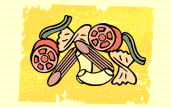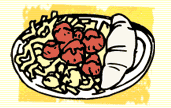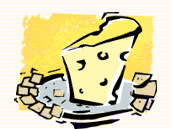
Food

If you go for a meal in a restaurant with Italian friends you will probably find this to be a long drawn-out affair with many courses! You do not have to order every course, but you will find that Italians take their food and drink very seriously. For a quicker meal a pizzeria or trattoria would probably fit the bill. Wherever you eat, buon appetito!
Restaurant menus will normally be divided up as follows and each region will have its own specialities.
Antipasti
These are what we would call hors d’oeuvres or starters, and are likely to include crostini (small toasted slices of bread) with various toppings. Antipasto misto would be a selection of meats, raw vegetables etc. Prosciutto crudo (uncooked ham) is also often served with melon or fresh figs (fichi).

Primi Piatti
These are the first courses, probably pasta, soup or rice dishes.
There is such a large range of pasta available in supermarkets outside of Italy that it hardly seems necessary any longer to explain what they all are! The word “pasta” actually means dough or pastry (the same word is used for sweet pastries in a cake shop). The type used for each dish depends on the heaviness of the sauce and whether the pasta is to be stuffed or not. The finer types of pasta (e.g. semini and vermicelli) are likely to be found floating in soups. Where the pasta is to be boiled and served with a thin sauce you will find spaghetti or tagliatelle (ribbon-shaped strands) etc. and with a more robust sauce fusilli (twists), penne (small tubes) or farfalle (bows). For a meat, spinach and ricotta (light white sweet whey cheese) or cream stuffing, ravioli (pouches) or canneloni (large tubes) will be used.
If you are unfamiliar with the range of pasta sauces, you may find the following helpful:
|
al pomodoro |
with a tomato sauce |
| al ragu |
with a minced meat sauce |
| in bianco | served plain with just butter and a sprinkling of parmesan cheese |
| al forno |
baked in the oven (e.g. lasagne al forno, which has a minced meat and tomato sauce with a white bechamel sauce topping) |
| ai funghi | with a mushroom sauce |
| alla carbonara |
usually spaghetti served with bacon or pork, egg yolk and sometimes parmesan |
Secondi Piatti
These are the second courses, usually meat, poultry or fish dishes. They will be served in various styles and again with various sauces.
Bistecca (steak), cotoletta (cutlet), pollo (chicken), agnello (lamb), maiale (pork), manzo (beef), vitello (veal), trota (trout), tonno (tuna) may feature here in various guises:
|
alla griglia |
grilled |
| alla brace |
grilled (maybe over an open fire) |
| arrosto | roasted |
| bollito |
boiled |
| fritto | fried |
| al vino bianco / rosso |
cooked in white / red wine |
| all’olio |
cooked in oil |
| al burro |
cooked in butter |
| alla milanese |
dipped in egg and breadcrumbs then fried |
| all’arrabbiata |
served with a hot tomato and chilli sauce |
Contorni
These are vegetables or salad, often served and eaten separately from the other courses.
|
Insalata |
salad |
| Insalata verde |
green salad |
| Insalata mista | mixed salad |
| Patate fritte |
fried potatoes |
| Fagioli | beans |
| Spinaci |
spinach |
| Zucchini |
courgettes |
| Pomodori |
tomatoes |
| Piselli |
peas |
| Melanzana |
aubergine |

DOLCE
There is not the enormous range of desserts, pies and puddings that we are used to in the UK. Italians tend to finish their meal with fresh fruit (frutta), cheese (formaggio) or icecream (gelato). You may see a few more regional dishes though if you are lucky.
|
Frutta della stagione |
Fruit in season |
| Torta della casa |
A cake which is a speciality of that restaurant |
| Macedoine | Fruit salad |
| Zabaglione |
Egg yolks, marsala and sugar whipped together to make a creamy confection. |
| Parmigiano | Parmesan cheese (a hard and very strong flavoured cheese) |
| Pecorino |
Another hard cheese but made from sheep’s milk. |

and talk to one of us, not a call centre info@onestopitaly.com
© 2000-2025 One Stop Italy. 19 Childs Road, Hethersett, Norwich NR9 3HW, UK